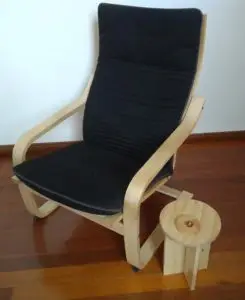I find that store bought side tables fall into one or more categories:
- Expensive for something that is not excessively big.
- Cheap but not very sturdy.
- Wrong size (generally height) for where I want to use it.
And I certainly don’t like those made from manufactured wood. Chipboard and mdf have their place, but not in furniture I make.
So, I make my own tables. My design approach is not necessarily all that original in that I scan the internet for ideas and for the basics of my design. I also look at the chair that the table is meant to go with and try to think of how the chair and table match. My current favourite shape for the table-top is circular, but I am considering trying oval shaped tables as an alternative. Then once I know what I want the table to look like I start sketching it out and working out how I do my cuts and joins to get the desired look. I also try to work out how it all goes together and if there is any sequence or approach to final construction that needs to be considered.
Having got the shape sorted (which to me is the mechanics of the design), I then work out my sizes and what materials to use.
Being someone who does not like to see wood going to waste, I often check my stockpile of offcuts and leftovers to see what can be used for the new project. This may then take me back to tweaking the design.
Depending on the complexity, I may draw out parts of the design at full size and create templates to assist in the construction. It is then into the workshop to start the cutting.
I always dry assemble the table before I do final assembly because invariably there is some aspect of the construction I hadn’t fully thought out. Also, I do whatever sanding I can before assembly and then finish sand after.
The accompanying photo shows a small side table I made to go with an Ikea POÄNG armchair. I discovered how comfortable this chair was in an AirBNB in New Zealand and after buying one needed something to put decide it to hold my morning coffee. Hence, a side table made from pine plywood (top) and laminated pine (legs).
